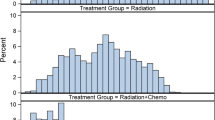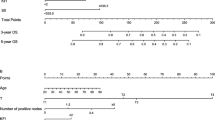Abstract
Background
Floor of mouth squamous cell carcinoma (SCCFOM) is a rare but aggressive malignancy with 5-year overall survival (OS) rates below 40% in published studies. However, the clinicopathological predictors of the prognosis of SCCFOM remain undefined. We aimed to establish a model to predict the survival outcomes of SCCFOM.
Methods
We searched the Surveillance, Epidemiology, and End Results (SEER) database for patients diagnosed with SCCFOM between 2000 and 2017. Data on patient demographics, treatment modalities, and survival outcomes were retrieved. Risk factors for OS were evaluated by survival and Cox regression analyses. A nomogram for OS was developed based on the multivariate model and split the patients into high- and low-risk cohorts based on cutoff values.
Results
Overall, 2014 SCCFOM patients were included in this population-based study. Multivariate Cox regression showed that age, married status, grade, American Joint Committee on Cancer stage, radiotherapy, chemotherapy, and surgery were significant risk factors for survival. A nomogram was established using the regression model. The C-indices, areas under the receiver operating characteristic curves, and calibration plots demonstrated the reliable performance of the nomogram. Patients assigned to the high-risk group had a significantly lower survival rate.
Conclusions
The nomogram predicting survival outcomes of SCCFOM patients based on clinical information showed good discriminative ability and prognostic accuracy. Our nomogram could be used to predict the survival probabilities for SCCFOM patients at different timepoints.



Similar content being viewed by others
Data Availability
Data were collected from the Surveillance, Epidemiology, and End Results (SEER)–Medicare linked data set from 2000 to 2017, using the Case Listing Session of SEER*Stat software (National Cancer Institute, Bethesda, MD; version 8.4.0.1). The SEER database is an open source database that allows global researchers to apply for data.
References
Siegel RL et al (2022) Cancer statistics, 2022. CA Cancer J Clin 72(1):7–33
Shield KD et al (2017) The global incidence of lip, oral cavity, and pharyngeal cancers by subsite in 2012. CA Cancer J Clin 67(1):51–64
Zhang Y et al (2015) Different levels in alcohol and tobacco consumption in head and neck cancer patients from 1957 to 2013. PLoS ONE 10(4):e0124045
Winn DM et al (2015) The INHANCE consortium: toward a better understanding of the causes and mechanisms of head and neck cancer. Oral Dis 21(6):685–693
Saggi S et al (2018) Clinicopathologic characteristics and survival outcomes in floor of mouth squamous cell carcinoma: a population-based study. Otolaryngol Head Neck Surg 159(1):51–58
Ong YLR et al (2021) Factors affecting surgical mortality of oral squamous cell carcinoma resection. Int J Oral Maxillofac Surg 50(1):1–6
Johnson DE et al (2020) Head and neck squamous cell carcinoma. Nat Rev Dis Primers 6(1):92
Lenze NR et al (2020) Age and risk of recurrence in oral tongue squamous cell carcinoma: systematic review. Head Neck 42(12):3755–3768
Kawachi MH et al (2010) NCCN clinical practice guidelines in oncology: prostate cancer early detection. J Natl Compr Canc Netw 8(2):240–262
Wang H et al (2022) A nomogram for predicting survival in patients with colorectal cancer incorporating cardiovascular comorbidities. Front Cardiovasc Med 9:875560
Bao D et al (2022) Construction of a nomogram model for predicting peritoneal dissemination in gastric cancer based on clinicopathologic features and preoperative serum tumor markers. Front Oncol 12:844786
Jia X et al (2022) Predicting checkpoint inhibitors pneumonitis in non-small cell lung cancer using a dynamic online hypertension nomogram. Lung Cancer 170:74–84
Ballantyne AJ (1970) Malignant melanoma of the skin of the head and neck. An analysis of 405 cases. Am J Surg 120(4):425–431
Chi AC, Day TA, Neville BW (2015) Oral cavity and oropharyngeal squamous cell carcinoma–an update. CA Cancer J Clin 65(5):401–421
Nelson AM et al (2016) Oncologic care and pathology resources in Africa: survey and recommendations. J Clin Oncol 34(1):20–26
Zhang S et al (2021) Central neck lymph node metastasis in oral squamous cell carcinoma at the floor of mouth. BMC Cancer 21(1):225
Fang Q et al (2020) Elective neck dissection versus wait-and-see policy in cT1N0 buccal squamous cell carcinoma. BMC Cancer 20(1):537
Ferri A et al (2020) Transoral resection with buccinator flap reconstruction vs. pull-through resection and free flap reconstruction for the management of T1/T2 cancer of the tongue and floor of the mouth. J Craniomaxillofac Surg 48(5):514–520
Piazza C et al (2019) Compartmental surgery for oral tongue and floor of the mouth cancer: oncologic outcomes. Head Neck 41(1):110–115
Baba A et al (2021) Assessment of squamous cell carcinoma of the floor of the mouth with magnetic resonance imaging. Jpn J Radiol 39(12):1141–1148
Sudhakar GVS et al (2022) The interrelation among triad of depth of invasion, perineural invasion and tumor size in squamous cell carcinoma of tongue and floor of the mouth: an analytical appraisal. J Maxillofac Oral Surg 21(2):350–357
McMahon J et al (2021) Operative tactics in floor of mouth and tongue cancer resection—the importance of imaging and planning. Br J Oral Maxillofac Surg 59(1):5–15
Hosni A et al (2021) Non-operative management for oral cavity carcinoma: definitive radiation therapy as a potential alternative treatment approach. Radiother Oncol 154:70–75
Fujiwara RJT et al (2017) Treatment guidelines and patterns of care in oral cavity squamous cell carcinoma: primary surgical resection vs. nonsurgical treatment. Oral Oncol 71:129–137
Konishi M et al (2022) Brachytherapy with (198)Au grains for cancer of the floor of the mouth: relationships between radiation dose and complications. Oral Radiol 38(1):105–113
Blažek T et al (2021) Dose escalation in advanced floor of the mouth cancer: a pilot study using a combination of IMRT and stereotactic boost. Radiat Oncol 16(1):122
Wong ATT et al (2017) Symptom burden and dysphagia associated with osteoradionecrosis in long-term oropharynx cancer survivors: a cohort analysis. Oral Oncol 66:75–80
Spijkervet FKL et al (2019) Research frontiers in oral toxicities of cancer therapies: osteoradionecrosis of the jaws. J Natl Cancer Inst Monogr 2019(53):Igz006
Acknowledgements
This research did not receive any specific grant from funding agencies in the public, commercial, or not-for-profit sectors.
Author information
Authors and Affiliations
Corresponding author
Ethics declarations
Conflict of interest
The authors have no funding, financial relationships, or conflicts of interest to disclose.
Additional information
Publisher's Note
Springer Nature remains neutral with regard to jurisdictional claims in published maps and institutional affiliations.
Rights and permissions
Springer Nature or its licensor (e.g. a society or other partner) holds exclusive rights to this article under a publishing agreement with the author(s) or other rightsholder(s); author self-archiving of the accepted manuscript version of this article is solely governed by the terms of such publishing agreement and applicable law.
About this article
Cite this article
Cao, Y., Liu, W. & Gu, D. A nomogram for predicting overall survival of patients with squamous cell carcinoma of the floor of the mouth: a population-based study. Eur Arch Otorhinolaryngol 280, 3867–3875 (2023). https://doi.org/10.1007/s00405-023-07971-5
Received:
Accepted:
Published:
Issue Date:
DOI: https://doi.org/10.1007/s00405-023-07971-5




